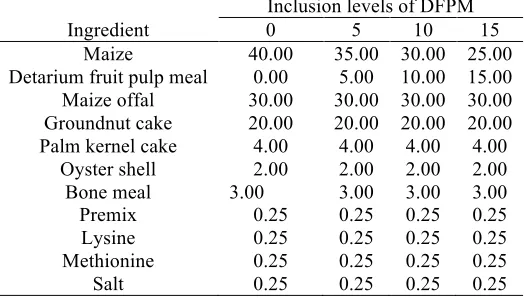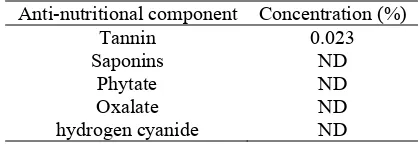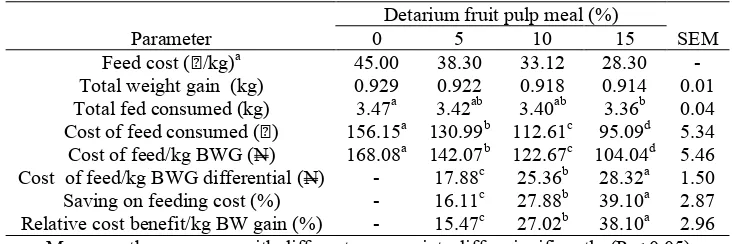ISSN: 15794377
EVALUATION OF
Detarium microcarpum
PULP MEAL AS FEED
INGREDIENT IN RABBITS DIETS
C. O. Obun1, S. M. Yahaya2, A .A. Kibon3, O. A. Olafadehan4,*, and S. D. Alison2 1
Department of Animal Production, Federal College of Wildlife Management, P.M.B.268, New Bussa, Niger State Nigeria
2Federal University of Technology, P.M. B. 2076, Yola, Adamawa State, Nigeria 3Department of Animal Science, University of Maiduguri, Borno State
4
Department of Animal Science, University of Abuja, Abuja, Nigeria [email protected]
ABSTRACT
A 12-week study was conducted to investigate response of weaner rabbits to diets containing graded levels, 0, 5, 10 and 15%, of dietary Detarium microcarpum fruit pulp meal (DFPM). Twenty-four, 4-week-old mixed breed weaner rabbits divided into 4 groups of 6 rabbits were randomly assigned to the four dietary treatments in a completely randomized design. The results of the phytochemical assay shows that DFPM contained tannins (0.023%) whereas saponins, phytate, oxalates and hydrogen cyanides were not detected. Feed intake was significantly (P < 0.05) lower in 15% DFPM than in the control diet. Daily weight gain, nutrients intake, protein to gain ratio and feed conversion ratio were not (P > 0.05) influenced by the dietary treatments. Similarly, nutrients digestibility was similar (P > 0.05) among the treatments. However, cost of feeding and feed cost per kg body weight gain (BWG) decreased (P < 0.05) with increasing levels of DFPM in the diets. Cost differential per kg BWG, savings of feed cost and relative cost benefit per kg BWG significantly (P < 0.05) varied among the diets; the rank order is: 15% > 10% > 5% DFPM. The impressive performance and comparative cost advantage suggests that DFPM is an economic viable alternative feedstuff and can be used up to 15% in the diets of weaner rabbits.
KEYWORDS
Detarium fruitpulp meal, digestibility, Economic analysis, performance, rabbits.
INTRODUCTION
One major limiting factor to livestock production is the high cost of conventional feedstuffs such as groundnut cake (GNC), soybean cake, fish meal and maize. However, many feedstuffs, especially agro-industrial by-products which are usually of no feeding value to humans can alternatively be fed at cheaper cost to monogastric animals(1).
Maize is the main cereal involved in animal nutrition as the main energy source and constitutes 60 to 70% of monogastrics' diets, especially pigs and poultry. However, owing to its nutritional value, there has always been keen competition between human and animals for maize. This pressure on maize has resulted in its skyrocketing price with consequential increased cost of livestock production, which has further exacerbated animal protein consumption problem in tropical countries including Nigeria. This scenario has therefore led to an increasing interest in search for alternative non conventional agricultural products that can substitute for maize in livestock feed. One of such waste by-products is Detarium microcarpum fruit pulp.
Detarium microcarpum tree belongs to the family Caesalpinoideae and is found mostly in savannah forest of dried type. It is a highly yielding tree with large quantities of its fruits being left wasting every year in the field(2) and grows up to 9m in height. Currently, it is of less value as human food rather large numbers are cut down for fuel wood and charcoal production. For economic reasons, it is reasonable to cultivate and conserve this tree with desirable attributes to meet livestock feed shortage.The fruits, which dropped naturally when matured (November – May), are circular and disc-shaped, covered with dark brown fairly smooth skin and brittle when dry enclosing a sweet greenish pulp mixed with a tangled network of fibres surrounding the hard disc-shaped wrinkled stone containing one seed. The tree has been estimated to produce between 20 - 25kg of fruits/stand/annum and can withstand burning with high regeneration interval when cut down(3). Most of the presumed nutritionally advantageous properties of these seeds wastes (pulp) have been suggested to be associated with the carbohydrate fractions. Ogundun(4) stated that the pulp of the fruit is used as a source of food for man and livestock as it contains high level of carbohydrate. The fruit pulp has been reported to contain 85.90 - 90.00% dry matter, 4.00 - 8.31% crude protein, 2.55 - 3.50% crude fat, 3.20 - 4.27% ash, 20 - 25% crude fibre and 35 - 40% carbohydrate with 3.2 mg vitamin C and 64.5 g of sugar per 100 g (4,5). The main objectives of this study were to investigate the phytochemical constituents and the effect of replacement of maize with graded levels of DMPM on the performance, nutrient digestibility and cost implication of grower rabbits.
MATERIALS AND METHODS Experimental site
This study was carried out at the rabbit unit of the Teaching and Research Farm of Federal College of Wildlife Management, New Bussa, Niger state. It is located between latitude 70 80´ and 100 00´N longitude 40 30´ and 40 33´E. The temperature and relative humidity averaged 340C and 60% during the period of the study.
Processing of the experimental feedstuff
Dry Detarium microcarpum fruits were collected from New Bussa, Niger State, Nigeria. The fruits were sun-dried consistently until they were properly dried after which, they were lightly pounded (to avoid seed breakage) with a pestle and mortar to separate the seeds from the pulp (mesocarp). The seeds and pulp were sieved with a 1mm size sieve to separate seeds from the pulp meal.
Experimental diets, design and animal management
replicates of three rabbits. The four experimental diets had the graded inclusion levels 0, 5, 10 and 15% Detarium fruit pulp meal (DFPM) which corresponded to 0, 12.5, 25.0 and 37.5% replacement of dietary maize (Table 1) in a complete randomized design. The experimental rabbits, housed in cages, were fed basal diet of
Table 1: Ingredient composition of the experimental feedstuff and diets (%) Inclusion levels of DFPM
Ingredient 0 5 10 15 Maize 40.00 35.00 30.00 25.00 Detarium fruit pulp meal 0.00 5.00 10.00 15.00 Maize offal 30.00 30.00 30.00 30.00 Groundnut cake 20.00 20.00 20.00 20.00 Palm kernel cake 4.00 4.00 4.00 4.00
Oyster shell 2.00 2.00 2.00 2.00 Bone meal 3.00 3.00 3.00 3.00 Premix 0.25 0.25 0.25 0.25 Lysine 0.25 0.25 0.25 0.25 Methionine 0.25 0.25 0.25 0.25 Salt 0.25 0.25 0.25 0.25
Tridax procubens. They were dewormed prior to the commencement of the experiment. Feed and water were supplied ad libitum throughout the study period. Feed intake was taken as the difference between the feed served and the ort. Records of initial and weekly live weight, daily feed intake were kept while the feed conversion ratio (FCR) and protein to gain ratio were calculated.
Digestibility trial
Digestibility trial was conducted during the last week of the experiment by collecting the faecal samples. Collected faecal samples were pooled together and sub samples were taken, dried at 60oC to a constant weight and stored until needed for proximate analysis.
Economic analysis
Cost effectiveness of DFPM supplementation was assessed using prevailing market prices at the time of the experiment. The cost of the DFPM diet was estimated by computing the cost of labour for collection and processing of the fruit pulp. Feed consumption was used to multiply cost per kg of feed to obtain the cost of feeding. The feed cost per kg of body weight gain (BWG) was calculated by dividing the cost of feeding by BWG. The cost differential and relative cost benefit of the diet in relation to the control diet were calculated as follows: Cost differential (X) = Cost per kg BWG of control diet less cost per kg BWG of test diets, whereas relative cost benefit describes the percentage gain realized by feeding DFPM at the graded levels in relation to the control.
Chemical assay
The proximate composition of the experimental diets, DFPM, faecal samples and phytochemical constituents of DFPM were conducted according to the procedures of AOAC(6).
Statistical analysis
All data were subjected to one way analysis of variance using the completely randomized design as described by Steel and Torrie(7). Significant treatment means were separated using Duncan's multiple range tests(8).
RESULTS
Table 2: Chemical compositions of the test ingredient and the experimental diets
Inclusion levels of DFPM (%) Parameter (%) DFPM 0 5 10 15 Dry matter 87.50 90.21 91.00 91.53 91.77 Crude proteína 6.61 17.00 16.77 16.54 16.26 Fat 2.00 5.65 5.69 5.73 5.87 Crude fibre 2.59 5.87 5.62 5.35 5.30 Ash 3.40 5.10 4.97 5.00 5.12 Nitrogen free extract 62.80 55.59 57.75 57.61 57.72
Organic matter 84.10 85.11 86.03 86.53 86.65 ME (Kcal/kg) 3920 2738 2762.9 2787.2 2811
DFPM, Detarium fruit pulp meal
Table 3: Phytochemical screening of the Detarium fruit pulp meal
Anti-nutritional component Concentration (%) Tannin 0.023
Saponins ND
Phytate ND
Oxalate ND
hydrogen cyanide ND
ND, Not detected
The performance of the rabbits fed the test diets is shown in Table 4. Final body weight, weight gains, daily weight gains, intakes of crude protein, fibre, nitrogen free extract, organic matter, protein intake to gain ratio and FCR were not significantly (P > 0.05) influenced by the treatments. While daily feed intake of rabbits fed the control and those fed 5 and 10% DFPM diets was not significantly (P > 0.05) different, feed intake of the control was significantly (P < 0.05) higher than that of the 15% DFPM. However, feed intake was similar (P > 0.05) among the rabbits fed DFPM diets.
The result of the apparent nutrient digestibility of the experimental rabbits is presented in Table 5. The apparent digestibility of the dry matter and nutrients were similar (P > 0.05) among the treatments.
Table 4: Intake and growth of rabbits fed Detarium fruit pulp meal
Detarium fruit pulp meal (%)
Parameter 0 5 10 15 SEM
Initial body weight (g) 330 328 329 331 4.90 Final body weight (g) 1259 1250 1247 1245 7.98 Weight gain (g) 929 922 918 914 6.89 Daily weight gain (g/day) 16.59 16.46 16.39 16.32 0.32 Daily feed intake (g/day) 62.00a 61.12ab 60.76ab 60.05b 0.71 Crude protein intake (g/day) 10.54 10.24 10.05 9.76 0.30 Crude fibre intake (g/day) 3.64 3.43 3.25 3.18 0.22 NFE intake (g/day) 34.47 35.30 35.00 34.66 0.53 Organic matter intake(g/day) 52.77 52.58 52.58 52.03 0.57 Protein intake: gain ratio 0.64 0.62 0.61 0.60 0.02 FCR 3.73 3.71 3.71 3.68 0.18 Means on the same row with different superscripts differ significantly (P < 0.05)
the DFPM diets; even among the DFPM diets, it was outstandingly lower in 15% DFPM than in 5% DFPM. Cost differential, savings of cost of feeding and relative cost benefit per kg BWG were significantly (P < 0.05) varied among the DFPM diets; the rank order is: 15% DFPM > 10% DFPM > 5% DFPM.
Table 5: Apparent nutrient digestibility of rabbit fed experimental diets (%) Detarium fruit pulp meal (%)
Parameter 0 5 10 15 SEM Dry matter 82.21 81.60 83.44 78.53 1.96 Crude proteína 78.56 77.54 74.83 77.67 1.65 Crude fibre 62.24 63.51 59.36 58.00 2.44 Ether extract 84.00 82.42 81.37 79.15 2.08 Nitrogen free extract 79.86 80.10 81.33 78.00 1.57 Means on the same row without superscripts are not significantly different (P > 0.05)
Table 6: Economics of feed conversion of rabbits fed the experimental diets
Detarium fruit pulp meal (%)
Parameter 0 5 10 15 SEM
Feed cost ( /kg)a 45.00 38.30 33.12 28.30 - Total weight gain (kg) 0.929 0.922 0.918 0.914 0.01 Total fed consumed (kg) 3.47a 3.42ab 3.40ab 3.36b 0.04 Cost of feed consumed ( ) 156.15a 130.99b 112.61c 95.09d 5.34 Cost of feed/kg BWG (N) 168.08a 142.07b 122.67c 104.04d 5.46 Cost of feed/kg BWG differential (N) - 17.88c 25.36b 28.32a 1.50 Saving on feeding cost (%) - 16.11c 27.88b 39.10a 2.87 Relative cost benefit/kg BW gain (%) - 15.47c 27.02b 38.10a 2.96
Means on the same row with different superscripts differ significantly (P < 0.05)
DISCUSSION
with large accumulations found in various plant tissues which are utilised for food and feed such as browse plants, legume seeds and forages. However, tannins, which have been reported to usually give rise to a dry, pickery, astringent sensation in the mouth(10) and bind with diet protein and other nutrients thus lowering diet intake and digestibility in animals(11), was low in the pulp meal.
To our knowledge there are no literature data on the performance of rabbits or other livestock fed DFPM. Therefore, the discussion in this study relies on other alternative feed resources and previous work on diets containing alternative feeds. The non significant differences in the final body weight, body weight gain and daily weight gain are in consonance with the previous studies involving other alternative feedstuffs such as processed cassava peel meal, different combinations of soybean-cheese waste meal, Rhodes grass, groundnut haulms, sweet potato forage and soybean forage, and graded levels of blood-wild sunflower leaf meal mixture, Oluremi and Nwosu(12), Iyeghre- Erakpotobor et al.(13) and Ajayi et al.(14), respectively, who also found no significant differences in the daily weight gains of the experimental rabbits. Furthermore, these weight gain values agree with what were reported previously in concentrate plus forage diets (15). Good weight gain response of animals is also an indication of feed utilization and thus implies the DFPM contains save level of toxic factors that could impede feed utilization. Therefore, the decreased daily feed intake of rabbit on 15% DFPM compared to the control may probably be due to the higher dietary energy content of this diet. It appears that feed intake is a logical consequence of the energy content of the diets. Lebas
et al.(16) asserted that rabbit adjusts its feed intake according to the energy concentration of the feeds offered to it where the proteins and other dietary components are balanced. Parallel observations were reported by Bamikole et al.(17) when graded levels of mulberry leaves were fed in combination with a concentrate diet to grower rabbits. Although the presence of tannins in DFPM could, as well, have been implicated because tannins in feed have been reported to act as toxin and/or digestion inhibitions with resultant depression in feed intake(9), the concentration of tannins in the DFPM is, however, very low and much lower than the range of 1 - 20% reported to have been commonly found in cereals and legumes and implicated for depressed feed intake and growth rate resulting in a poor feed efficiency and an increase in the amount of feed required per unit weight gain(18). Thus, the performance of animals on high tanniniferous feeds is usually low(11). The insignificant differences in the protein intake to gain ratio and FCR suggest that inclusion of DFPM up to 15% did not affect protein utilization and efficiency of conversion feed to meat. The results corroborates the findings of other workers(12,14,19).
The insignificant variations in apparent digestibility of the dry matter and nutrients explicitly demonstrated that DFPM can adequately partially replace maize in the diets of grower rabbits without adverse effect on nutrients digestibility. This again led credence to the non toxic level of tannins in the DFPM because it is well known that tannins inhibit digestive enzymes and increase endogenous and faecal nitrogen excretion that strongly depress protein digestibility as well as the digestibility of other nutrients in ruminants and monogastrics(20).
314
DFPM gave the best result. The results agree with that of Agunbiade et al.(22) who reported that savings in feed cost was achievable as a result of the use of dried cassava peel in rabbits diets. Since there is abundant availability of Detarium microcarpum plant and their fruits, which are allowed to rotten in the field, especially in the northern Nigeria, a farmer can harvest, processed and store at a very minimal cost for use in livestock feeding.
The results of this study, which show that DFPM can be used up to 15% and therefore replaced 37.5% of dietary maize in practical rabbit ration without any adverse effect on feed intake, growth rate, nutrient digestibility but even reduced the cost of rabbit production, suggest DFPM as a good energy feedstuff for rabbit. However, further research on higher inclusion levels is needed.
REFERENCES
1.T. A. Omole, O. O. Tewe. Res. Vet. Sci.38, 259– 263 (1985).
2.S.U. Okorie, E. C. Amechi. Global J. Pure Applied Sci. 9(2), 177-182 (2003). 3.S. Y. Giami, O. C. Wachukwu. Plant Foods for Human Nutr. 50(1), 27-36 (1997).
4.N. J. Ogundun. Appraisal of major minerals in the blood serum of goats fed Detarium mcrocarpum fruits and
Panicum maximum hay. Proc. 11th Annual Conference of Animal Science Association of Nigeria, 18- 24 Sept., Ibadan, Nigeria, pp. 114-116 (2006).
5.A. M. Kouyate, P. Damme. Detarium microcarpum Guill and sperr. (G. H. Schmelzer, A. Gurib-Fakim, eds.), Prota 11. Medicinal plants/plantes medicinales. Wageningen, Netherlands, pp. 1-9 (2006).
6.AOAC. Association of Official Analytical Chemists. Official Method of analysis, 15th edn.Washinton DC (1990).
7.R. G. D. Steel, J. H. Torrie. Principles and Procedures of Statistics. 2nd edn. McGraw –Hill Book Company, New York, pp. 633 (1980).
8.D. B. Duncan. Biometrics 11, 1–42 (1955).
9.A. A. Aganga, K. W. Mosase. Anim. Feed Sci. Technol. 91, 107-113 (2001). 10.O. I. A. Oluremi, J. Ngi, I. A. Andrew. Livest. Res. Rural Dev. 9(7) (2008). 11.H.P.S. Makkar. Small Rum. Res.49, 241-256 (2003).
12.O. I. A. Oluremi, A. Nwosu. J. Food Technol. Afr. 7, 12-15 (2002).
13.G. T. Iyeghe-Erakpotobor, R. Aliyu, J. Uguru. Afr. J. Biotechnol. 4(20), 2004-2008 (2004). 14.A. F. Ajayi, G. O. Farinu, O. O. Ojebiyi, T. B. Olayeni. World J. Agric. Sci. 3(2), 250-255 (2007). 15.M. A. Bamikole, I. Ezenwa. Anim. Feed Sci. Technol. 80, 67-74 (1999).
16.F. Lebas, P. Coudert, H. de Rochambeau, R. G. Thebault. The Rabbit - Husbandry, Health and Production. F.A.O., Rome, Italy (1997).
17.M. A. Bamikole, M. I. Ikhatua, U. J. Ikhatua, I. V. Ezenwa. Pak. J. Nutr. 4(4),231-236 (2005).
18.M. L. Price, L. G. Butler. Tannin and Nutrition. Purdue University Agricultural Experimental Station No. 272. West Lafayette, IN 47907-2054, USA (1980).
19.A. A. Adeniji, O. A. Omonijo. Livest. Prod. Sci. 85, 287-291 (2004).
20.I. E. Liener. Naturally occurring toxic factors in animal feedstuffs. (J. Wiseman, D. J. A. Cole. eds.), Feedstuff Evaluation. Butterworths, London, pp. 120-135 (1990).


